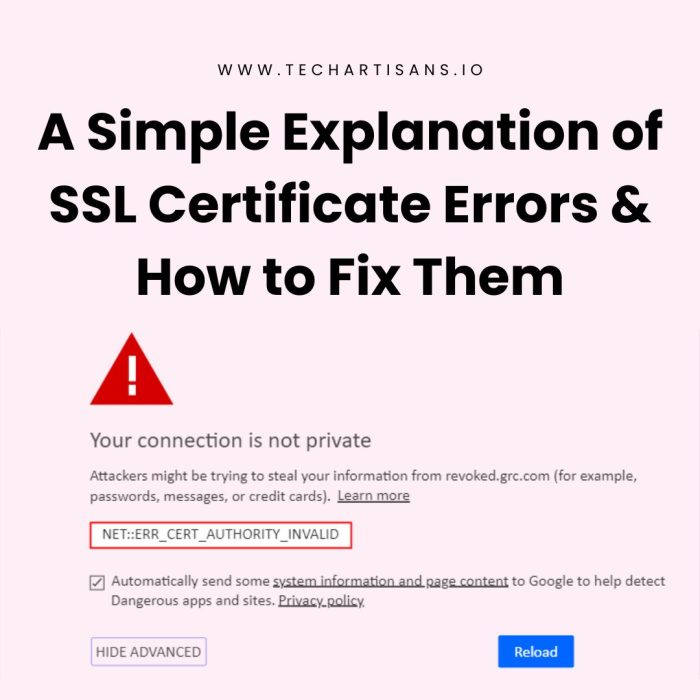In the digital landscape, where security is paramount, encountering an SSL connection error on your business platform can be daunting. SSL, or Secure Sockets Layer, certificate errors occur when your browser can’t establish a secure connection with the website you’re trying to visit. These certificates are crucial for online security, encrypting, and safeguarding data exchanged between browsers and servers. Their importance extends to your website’s credibility and search engine ranking. This blog simplifies the seemingly complex SSL certificate errors, explaining what causes them and how to fix them. By the end, you will be ready to handle any SSL connection error, ensuring your business platform remains secure and trustworthy for your customers.
A Simple Explanation of SSL Certificate Errors & How to Fix Them
Let’s discover how to understand and resolve common SSL connection errors in this simple guide.
Common SSL Certificate Errors
SSL certificate errors happen when your certificate expires or doesn’t match your website’s domain. To avoid these errors, renew your certificate on time and keep it in sync with your domain.
Mixed content errors occur when you have secure (HTTPS) and insecure (HTTP) content, which can scare off users. To fix it, replace or remove the insecure content.
Impact of SSL Certificate Errors on Websites
SSL certificate errors can harm the trust your customers have in your business. When users encounter an SSL connection error, it raises doubts about your site’s security, making them question the safety of their data. This can result in less traffic, lower conversion rates, and even loss of business.
Real-World Examples of SSL Certificate Errors
Let’s delve into real-world instances where SSL certificate errors have impacted businesses negatively.
Big Brand Retailer Website
A renowned online retailer once experienced a significant dip in their traffic due to an expired SSL certificate. They failed to renew their certificate in time, resulting in an SSL connection error that deterred users from accessing their site. The incident resulted in substantial revenue loss and a hit to their brand reputation.
News Website
A popular news website made headlines for the wrong reasons when it switched to a new domain without updating its SSL certificate. Visitors were greeted with a mismatched domain name error, which caused them to question the site’s credibility and led to a decline in repeat visitors.
E-commerce Platform
An e-commerce platform once included HTTP content on its HTTPS website. This led to insecure connection errors, with browsers blocking the insecure content. The issue resulted in customer dissatisfaction, decreased users, and damaged SEO ranking.
Causes of SSL Certificate Errors
Let’s delve into the root causes of these errors, arming you with the knowledge needed to keep your business platform secure and error-free.
Technical Factors Leading to SSL Errors
SSL certificate errors can happen due to server misconfigurations, like incorrect installation or missing intermediate certificates. To avoid these issues, make sure your server is set up correctly. Another reason for SSL errors can be problems with the certificate authority (CA) not being trusted by the user’s browser.
User-Related Causes
SSL certificate errors can occur due to user-side issues like outdated browsers, incorrect date and time settings, or troublesome extensions. Keeping browsers updated and properly configured can prevent these errors. Obsolete systems may also lead to SSL connection errors as they may need to support the latest SSL protocols.
SSL/TLS Protocol Versions
SSL/TLS protocols are vital for secure web communication, encrypting data between a user’s browser and your website. They are regularly updated to enhance security. Yet, outdated protocol versions can cause SSL connection errors as modern browsers reject older, insecure ones. Similarly, users on outdated systems may encounter errors due to incompatible protocols.
How to Identify SSL Certificate Errors
Let’s explore effective methods for detecting these errors and the signs you must look for.
Methods for Detecting SSL Certificate Errors
Identifying SSL certificate errors is the first step towards maintaining a secure, user-friendly online platform for your business.
Browser Warnings
Web browsers play a pivotal role in detecting SSL certificate errors. They validate the SSL certificates of websites you visit and display warnings or error messages if any discrepancies or issues are found. This could range from expired certificates to mismatched domain names or untrusted certificate authorities.
Online SSL Certificate Checkers
Online SSL certificate checkers are invaluable tools for detecting SSL certificate errors. These checkers scan your website’s SSL certificate and provide a detailed report on its configuration, validity, and potential issues.
Importance of Regular Monitoring and Proactive Checks
Regular monitoring and bold reviews are paramount to maintaining an error-free SSL environment. They allow for early detection and resolution of SSL certificate errors, ensuring uninterrupted, secure services to your users. Regular checks can also help you stay ahead of SSL certificate expiry dates, preventing a sudden break in your security chain.
Fixing SSL Certificate Errors
Let’s learn how to fix common SSL connection errors and restore your website’s secure connection.
Step-by-step Guide
- Check your SSL certificate’s expiration date using tools like SSL Certificate Checkers.
- If expired, renew it through your Certificate Authority (CA), which usually involves requesting renewal, validating domain ownership, and installing the new certificate.
- Remove the old one from your server when replacing a certificate to avoid confusion and errors.
- Review your server’s SSL/TLS settings to ensure they are configured correctly.
- Ensure the correct SSL certificate is installed and your server is set up to use SSL/TLS.
- Update your server to support the latest SSL/TLS protocols and cipher suites for improved security.
- Seek documentation or support for server-specific issues or configuration assistance.
Troubleshooting Techniques for Mismatched Domain Names
An incompatible domain name error can happen when the domain in your SSL certificate doesn’t match your website’s domain. To fix it:
- Confirm that your website’s DNS records point to your server’s IP address.
- Make sure the domain in your SSL certificate matches your website’s domain. If your SSL certificate has the wrong part, you can resolve the error by:
- Contact your Certificate Authority (CA) to reissue the certificate with the correct domain.
- Installing the new certificate on your server and replacing the old one.
- Ensure your server’s SSL/TLS settings no longer reference the old, incorrect certificate.
Dealing With Insecure Connection Errors
To address insecure connection errors possibly due to browsers:
- Clear your browser’s cache and cookies to prevent data interference.
- Keep your browser updated to support the latest security protocols.
- Disable conflicting extensions or add-ons that can disrupt SSL/TLS. For server-related issues:
- Ensure your server backs the latest TLS protocol for improved security and browser compatibility.
- Phase out older, less secure protocols like SSL 2.0 or 3.0.
- Ensure your users’ systems support the latest TLS protocols for secure connections.
Tips for Preventing Future SSL Errors
To prevent SSL errors and keep your website secure, ensure your SSL certificate is always up to date, regularly check its expiration date, and renew it in advance. Also, periodically verify your server and SSL/TLS configuration for correct settings, especially after making changes. Use the latest SSL/TLS protocols and cipher suites to enhance security, as outdated protocols can lead to errors and security vulnerabilities.
Conclusion
SSL certificate errors, such as ssl connection errors, significantly impact your website’s credibility and user trust. Dealing with and preventing these errors is doable with the right know-how and some proactive steps. If you own a website, keeping your SSL certificates up to date is crucial, ensuring your server configurations are on point and staying in the loop about the latest protocols. SSL security isn’t just a badge on your website; it’s a key part of your online business’s safety and reputation. When you provide a secure and smooth user experience, you show your dedication to user privacy and data protection.







